Intermediate CartoDB Workshop for MSc GIS & Remote Sensing
- Speaker: Ramiro Aznar · ramiroaznar@cartodb.com · @ramiroaznar
- May 19th 2016
- MSc GIS & Remote Sensing · Universidad de Zaragoza · Zaragoza
http://bit.ly/cdb-zgz-workshop
Contents
- Importing datasets
- Getting your data ready
- Making a map
- Going spatial with PostGIS
- Webmapping apps with CartoDB.js
Intermediate CartoDB Workshop for MSc GIS & Remote Sensing
0. Before we start…
- Import API allows to upload new data to CartoDB.
- SQL API allows to interact with CartoDB tables. Query and modify CartoDB tables.
- Maps API allows to visualize the underlying data.
The CartoDB Editor is a client of the platform
1. Importing datasets
1. 1. Supported Geospatial Data Files
CartoDB supports the following geospatial data formats to upload vector data*:
Shapefile.KML.KMZ.GeoJSON**.CSV.Spreedsheets.GPX.OSM.
*Importing different geometry types in the same layer or in a FeatureCollection element (GeoJSON) is not supported. More detailed information here. **More detailed information about GeoJSON format here, here and here.
1. 2. Common importing errors
- Dataset too large:
- File size limit: 150 Mb (free).
- Import row limit: 500,000 rows (free).
- Solution: split your dataset into smaller ones, import them into CartoDB and merge them.
- Malformed CSV:
- Solution: check termination lines, header…
- Solution: check termination lines, header…
- Encoding:
- Solution:
Save with Encoding>UTF-8 with BOMin Sublime Text.
- Solution:
- Shapefile missing files:
- Missing any of the following files within the compressed file will produce an importing error:
.shp: contains the geometry. REQUIRED..shx: contains the shape index. REQUIRED..prj: contains the projection. REQUIRED..dbf: contains the attributes. REQUIRED.
- Other auxiliary files such as
.sbn,.sbxor.shp.xmlare not REQUIRED. - Solution: make sure to add all required files.
- Missing any of the following files within the compressed file will produce an importing error:
- Duplicated id fields:
- Solution: check your dataset, remove or rename fields containing the
idkeyword.
- Solution: check your dataset, remove or rename fields containing the
- Format not supported:
- URLs -that are not points to a file- are not supported by CartoDB.
- Solution: check for missing url parameters or download the file into your local machine, import it into CartoDB.
- MAYUS extensions not supported:
example.CSVis not supported by CartoDB.- Solution: rename the file.
Other importing errors and their codes can be found here.
2. Getting your data ready
2. 1. Geocoding
If you have a column with longitude coordinates and another with latitude coordinates, CartoDB will automatically detect and covert values into the_geom. If this is not the case, CartoDB can help you by turning the named places into best guess of latitude-longitude coordinates:
- By Lon/Lat Columns.
- By City Names.
- By Admin. Regions.
- By Postal Codes.
- By IP Addresses.
- By Street Addresses.
Know more about geocoding in CartoDB:
- In this tutorial.
- In our Location Data Services website.
- In our documentation.
2. 2. Datasets
- Populated Places [
ne_10m_populated_places_simple]: City and town points. - World Borders [
world_borders]: World countries borders. - Land [
ne_50m_land]: World emerged lands. - European countries [
ne_adm0_europe]: European countries geometries.
2. 3. Selecting
- Selecting all the columns:
SELECT
*
FROM
ne_10m_populated_places_simple;
- Selecting some columns:
SELECT
cartodb_id,
name as city,
adm1name as region,
adm0name as country,
pop_max,
pop_min
FROM
ne_10m_populated_places_simple
- Selecting distinc values:
SELECT DISTINCT
adm0name as country
FROM
ne_10m_populated_places_simple
2. 4. Filtering

- Filtering numeric fields:
SELECT
*
FROM
ne_10m_populated_places_simple
WHERE
pop_max > 5000000;
- Filtering character fields:
SELECT
*
FROM
ne_10m_populated_places_simple
WHERE
adm0name ilike 'spain'
- Filtering a range:
SELECT
*
FROM
ne_10m_populated_places_simple
WHERE
name in ('Madrid', 'Barcelona')
AND
adm0name ilike 'spain'
- Combining character and numeric filters:
SELECT
*
FROM
ne_10m_populated_places_simple
WHERE
name in ('Madrid', 'Barcelona')
AND
adm0name ilike 'spain'
AND
pop_max > 5000000
2. 5. Others:
- Selecting aggregated values:
SELECT
count(*) as total_rows
FROM
ne_10m_populated_places_simple
SELECT
sum(pop_max) as total_pop_spain
FROM
ne_10m_populated_places_simple
WHERE
adm0name ilike 'spain'
SELECT
avg(pop_max) as avg_pop_spain
FROM
ne_10m_populated_places_simple
WHERE
adm0name ilike 'spain'
- Ordering results:
SELECT
cartodb_id,
name as city,
adm1name as region,
adm0name as country,
pop_max
FROM
ne_10m_populated_places_simple
WHERE
adm0name ilike 'spain'
ORDER BY
pop_max DESC
- Limiting results:
SELECT
cartodb_id,
name as city,
adm1name as region,
adm0name as country,
pop_max
FROM
ne_10m_populated_places_simple
WHERE
adm0name ilike 'spain'
ORDER BY
pop_max DESC LIMIT 10
3. Making a map
3. 0. Before making maps…
CartoDB make maps using SQL queries, not tables!
3. 1. Wizard
Analyzing your dataset… In some cases, when you connect a dataset and click on the MAP VIEW for the first time, the Analyzing dataset dialog appears. This analytical tool analyzes the data in each column, predicts how to visualize this data, and offers you snapshots of the visualized maps. You can select one of the possible map styles, or ignore the analyzing dataset suggestions.
- Simple Map.
- Cluster Map.
- Category Map.
- Bubble Map.
- Torque Map.
- Heatmap Map.
- Torque Cat Map.
- Intensity Map.
-
Density Map.
- Choropleth Map:
Before making a choropleth map, we need to normalize our target column. So we are going to create two new columns with numeric as data type: new_area and po_norm. Finally, run the following SQL queries to update their values:
UPDATE
world_borders
SET
new_area = round(st_area(the_geom)::numeric, 6)
UPDATE
world_borders
SET
pop_norm = pop2005 / new_area
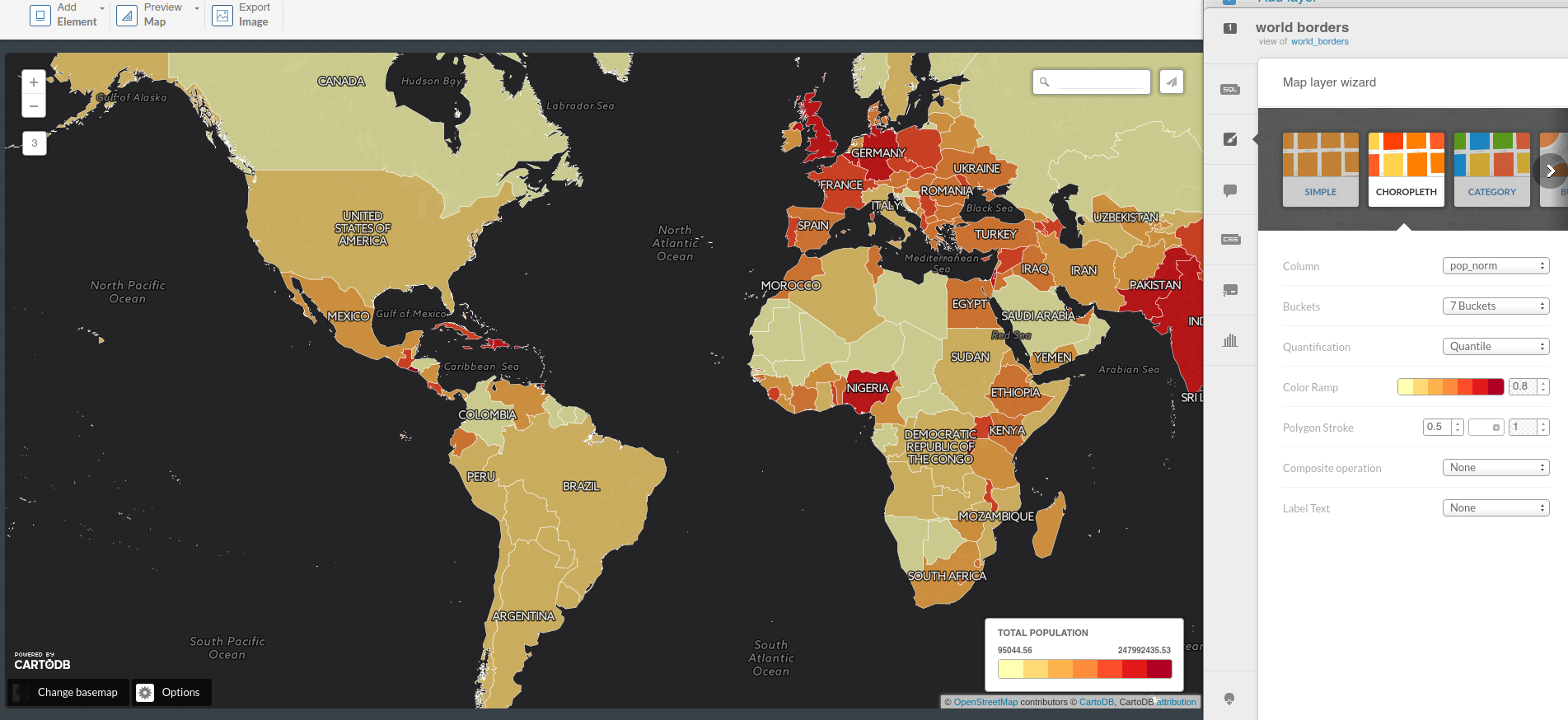
Know more about chosing the right map to make here.
3. 2. Styles
- Simple Map:
/** simple visualization */
#world_borders{
polygon-fill: #FF6600;
polygon-opacity: 0.7;
line-color: #FFF;
line-width: 0.5;
line-opacity: 1;
}
- Choropleth Map:
/** choropleth visualization */
#world_borders{
polygon-fill: #FFFFB2;
polygon-opacity: 0.8;
line-color: #FFF;
line-width: 0.5;
line-opacity: 1;
}
#world_borders [ pop_norm <= 247992435.530086] {
polygon-fill: #B10026;
}
#world_borders [ pop_norm <= 4086677.23673585] {
polygon-fill: #E31A1C;
}
#world_borders [ pop_norm <= 1538732.3943662] {
polygon-fill: #FC4E2A;
}
#world_borders [ pop_norm <= 923491.374542489] {
polygon-fill: #FD8D3C;
}
#world_borders [ pop_norm <= 616975.331234902] {
polygon-fill: #FEB24C;
}
#world_borders [ pop_norm <= 326396.192958792] {
polygon-fill: #FED976;
}
#world_borders [ pop_norm <= 95044.5589361554] {
polygon-fill: #FFFFB2;
}
- Category Map.
- Bubble Map.
- Torque Map.
- Heatmap Map.
- Torque Cat Map.
- Intensity Map.
- Density Map.
Know more about CartoCSS with our documentation.
3. 3. Other elements
- Basemaps:
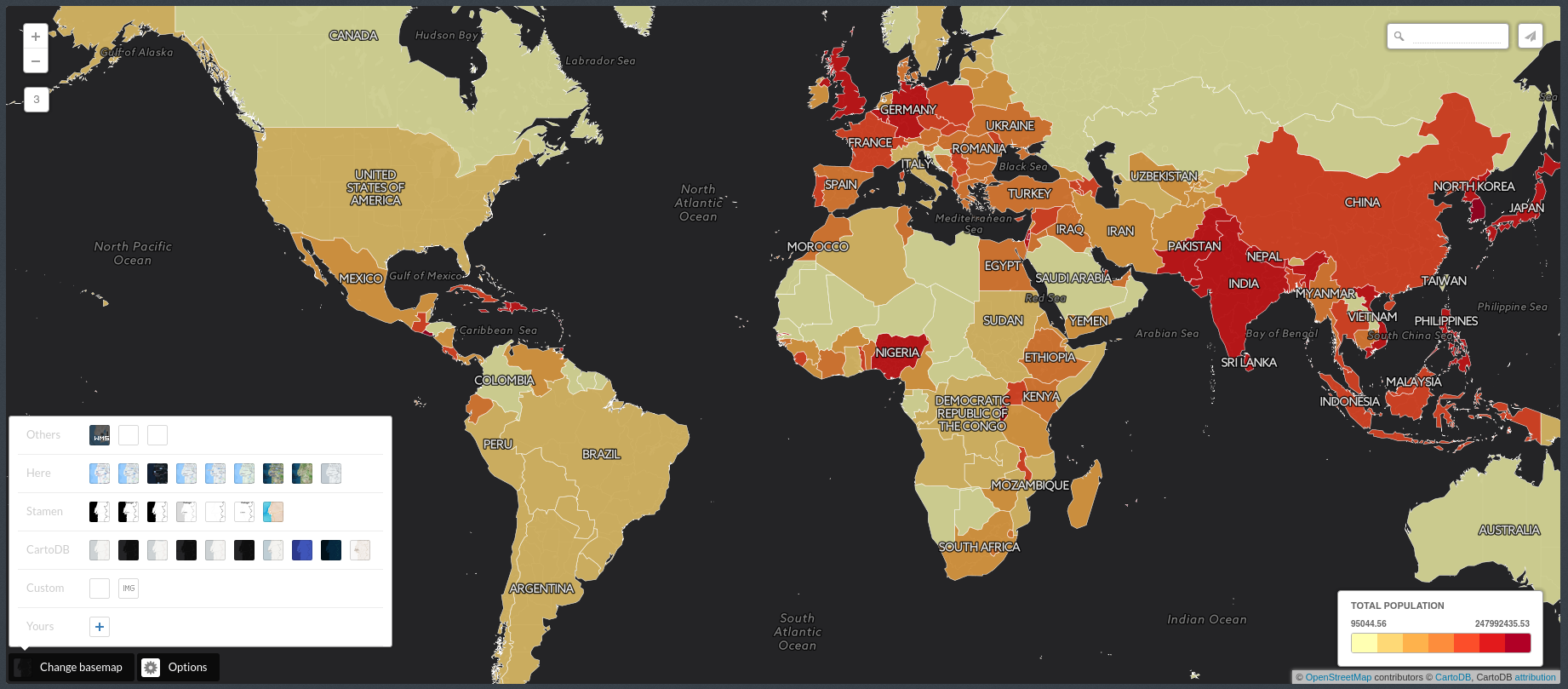
- Options:

- Legend:

<div class='cartodb-legend choropleth'>
<div class="legend-title">Total Population</div>
<ul>
<li class="min">
95044.56
</li>
<li class="max">
247992435.53
</li>
<li class="graph count_441">
<div class="colors">
<div class="quartile" style="background-color:#FFFFB2"></div>
<div class="quartile" style="background-color:#FED976"></div>
<div class="quartile" style="background-color:#FEB24C"></div>
<div class="quartile" style="background-color:#FD8D3C"></div>
<div class="quartile" style="background-color:#FC4E2A"></div>
<div class="quartile" style="background-color:#E31A1C"></div>
<div class="quartile" style="background-color:#B10026"></div>
</div>
</li>
</ul>
</div>
- Labels:

#world_borders::labels {
text-name: [name];
text-face-name: 'DejaVu Sans Book';
text-size: 10;
text-label-position-tolerance: 10;
text-fill: #000;
text-halo-fill: #FFF;
text-halo-radius: 1;
text-dy: -10;
text-allow-overlap: true;
text-placement: point;
text-placement-type: simple;
}
- Infowindows and tooltip:
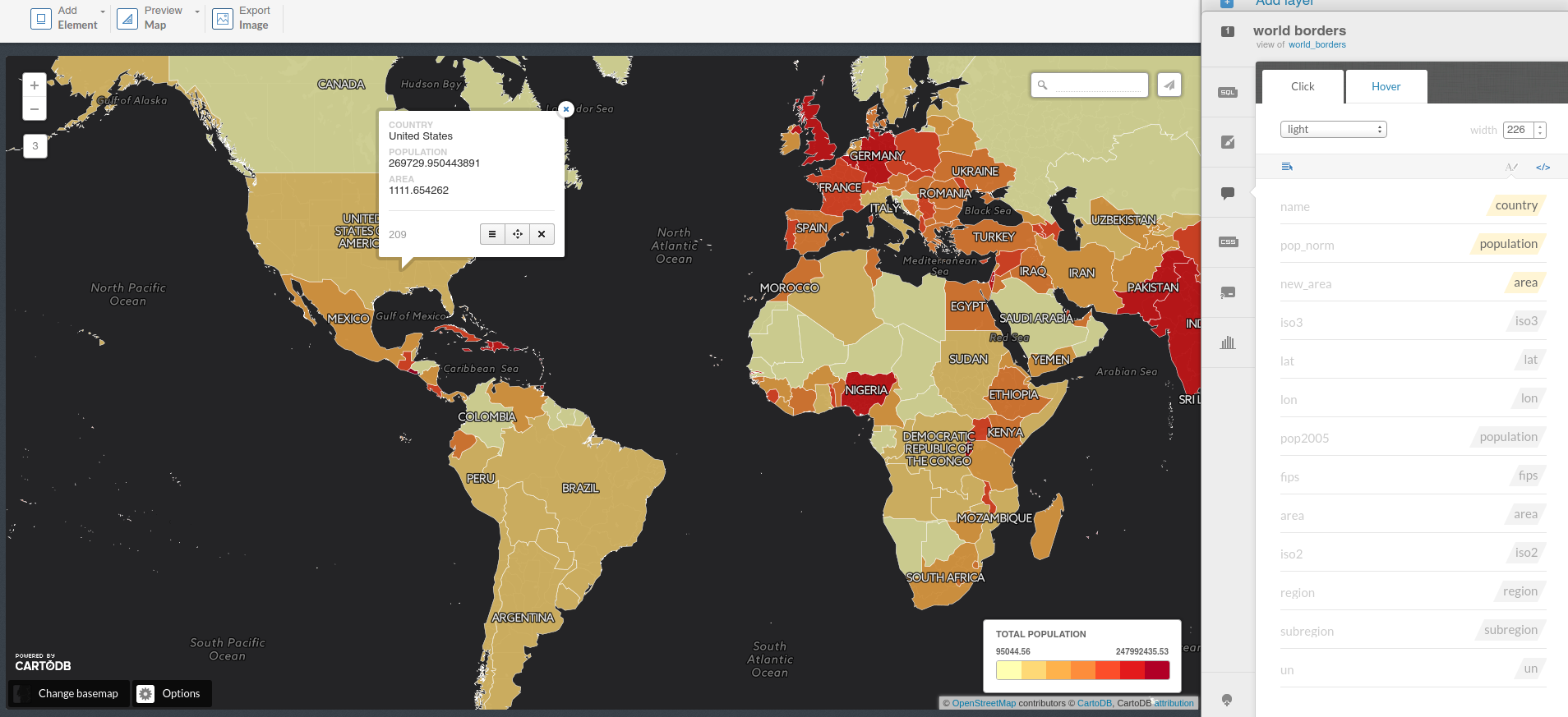
<div class="cartodb-popup v2">
<a href="#close" class="cartodb-popup-close-button close">x</a>
<div class="cartodb-popup-content-wrapper">
<div class="cartodb-popup-content">
<h4>country</h4>
<p></p>
<h4>population</h4>
<p></p>
<h4>area</h4>
<p></p>
</div>
</div>
<div class="cartodb-popup-tip-container"></div>
</div>
- Title, text and images:

3. 4. Share your map!

-
Get the link: https://team.cartodb.com/u/ramirocartodb/viz/0ba65c92-120b-11e6-9ab2-0e5db1731f59/public_map
-
Embed it:
- CartoDB.js [vizJSON file*]: https://team.cartodb.com/u/ramirocartodb/api/v2/viz/0ba65c92-120b-11e6-9ab2-0e5db1731f59/viz.json
*BONUS: JSONView, a Google Chrome extension and Pretty JSON, a Sublime Text plugin to visualize json files are good resources.
4. Going spatial with PostGIS
4. 1. Working with projections
4. 1. 1. geometry vs. geography
-
Geometryuses a cartesian plane to measure and store features (CRS units):The basis for the PostGIS
geometrytype is a plane. The shortest path between two points on the plane is a straight line. That means calculations on geometries (areas, distances, lengths, intersections, etc) can be calculated using cartesian mathematics and straight line vectors. -
Geographyuses a sphere to measure and store features (Meters):The basis for the PostGIS
geographytype is a sphere. The shortest path between two points on the sphere is a great circle arc. That means that calculations on geographies (areas, distances, lengths, intersections, etc) must be calculated on the sphere, using more complicated mathematics. For more accurate measurements, the calculations must take the actual spheroidal shape of the world into account, and the mathematics becomes very complicated indeed.
More about the geography type can be found here and here.

4. 1. 2. the_geom and the_geom_webmercator
the_geomEPSG:4326. Unprojected coordinates in decimal degrees (Lon/Lat). WGS84 Spheroid.the_geom_webmercatorEPSG:3857. UTM projected coordinates in meters. This is a conventional Coordinate Reference System, widely accepted as a ‘de facto’ standard in webmapping.
In CartoDB, the_geom_webmercator column is the one we see represented in the map. Know more about projections:
4. 2. Changing map projections
- Accessing the list of default projections available in CartoDB:
SELECT
*
FROM
spatial_ref_sys
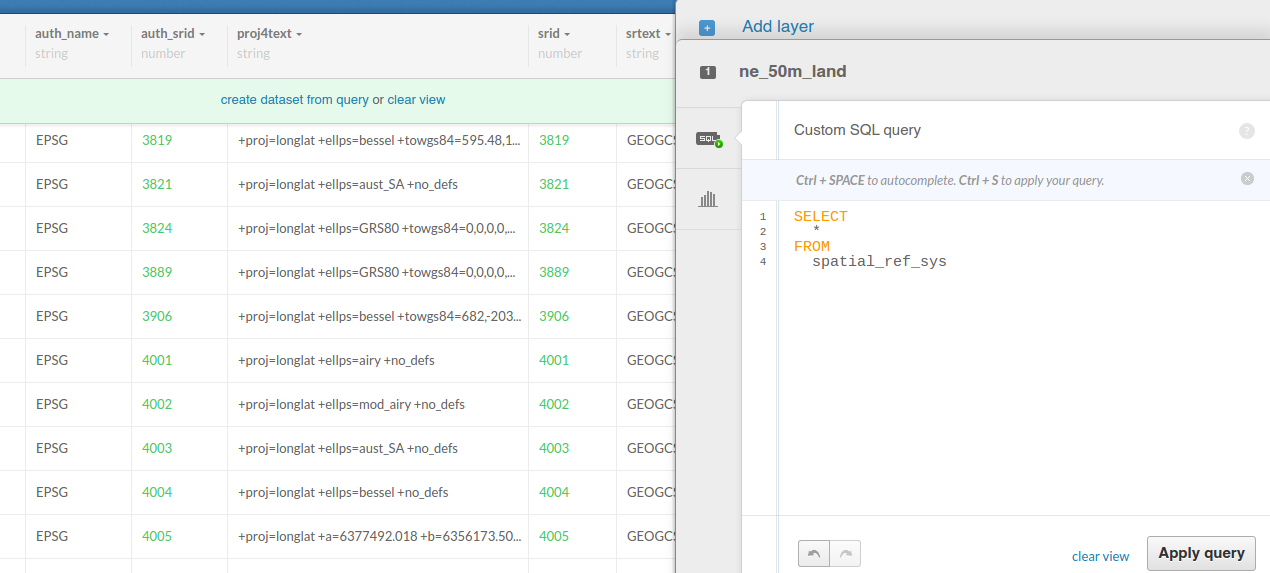
- Accessing the occult the_geom_webmercator field:
SELECT
the_geom_webmercator
FROM
ne_50m_land
- World Robinson projection (ESPG:54030):
INSERT INTO spatial_ref_sys
(srid, auth_name, auth_srid, proj4text, srtext) values (54030, 'EPSG', 54030,
'+proj=robin +datum=WGS84','PROJCS["World_Robinson",
GEOGCS["GCS_WGS_1984",
DATUM["WGS_1984",
SPHEROID["WGS_1984",6378137,298.257223563]],
PRIMEM["Greenwich",0],
UNIT["Degree",0.017453292519943295]],
PROJECTION["Robinson"],
PARAMETER["False_Easting",0],
PARAMETER["False_Northing",0],
PARAMETER["Central_Meridian",0],
UNIT["Meter",1],
AUTHORITY["EPSG","54030"]]');
SELECT
cartodb_id, ST_Transform(the_geom, 54030) AS the_geom_webmercator
FROM
ne_50m_land
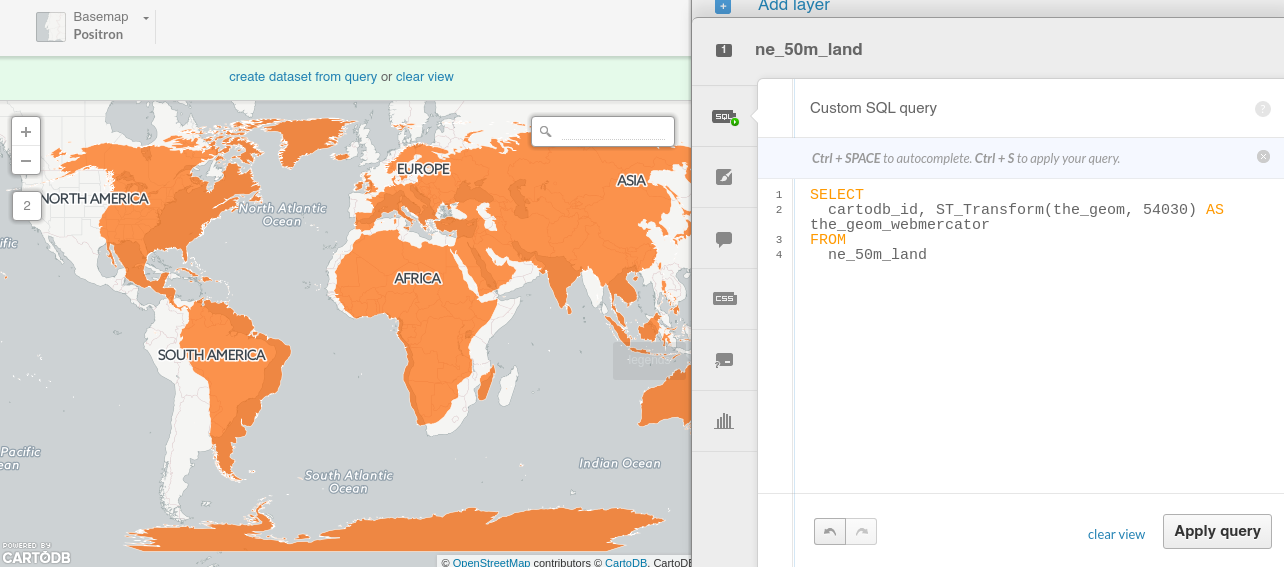
*About ST_Transform.
4. 3. Geoprocessing
- Create a buffer from points:
SELECT
cartodb_id,
name,
ST_Transform(
ST_Buffer(the_geom::geography, 50000)::geometry
,3857
) AS the_geom_webmercator
FROM
populated_places
WHERE
name ilike 'madrid'

*About ST_Buffer.
- Get the difference between two geometries:
SELECT
a.cartodb_id,
ST_Difference(
a.the_geom_webmercator,
b.the_geom_webmercator
) AS the_geom_webmercator
FROM
ne_50m_land a,
ne_adm0_europe b
WHERE
b.adm0_a3 like 'ESP'

*About ST_Difference.
- Know if tow geometries intersect:
SELECT
a.*
FROM
ne_10m_populated_places_simple a,
ne_adm0_europe b
WHERE
ST_Intersects(
b.the_geom_webmercator,
a.the_geom_webmercator
)
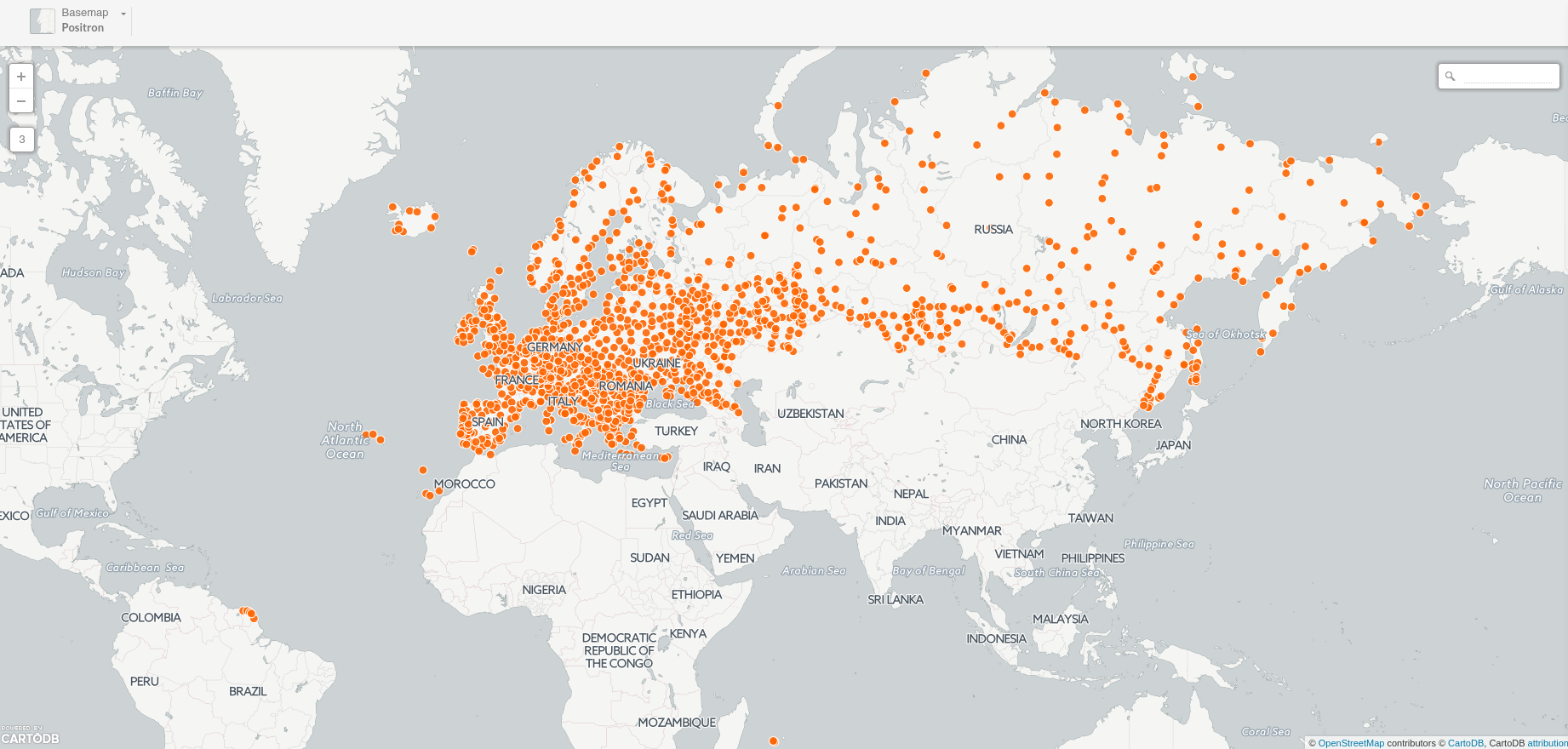
*About ST_Intersects.
- Know wether a geometry is within the given range from another geometry:
SELECT
a.*
FROM
ne_10m_populated_places_simple a,
ne_10m_populated_places_simple b
WHERE
a.cartodb_id != b.cartodb_id
AND ST_DWithin(
a.the_geom_webmercator,
b.the_geom_webmercator,
150000
)
AND a.adm0name = 'Spain'
AND b.adm0name = 'Spain'
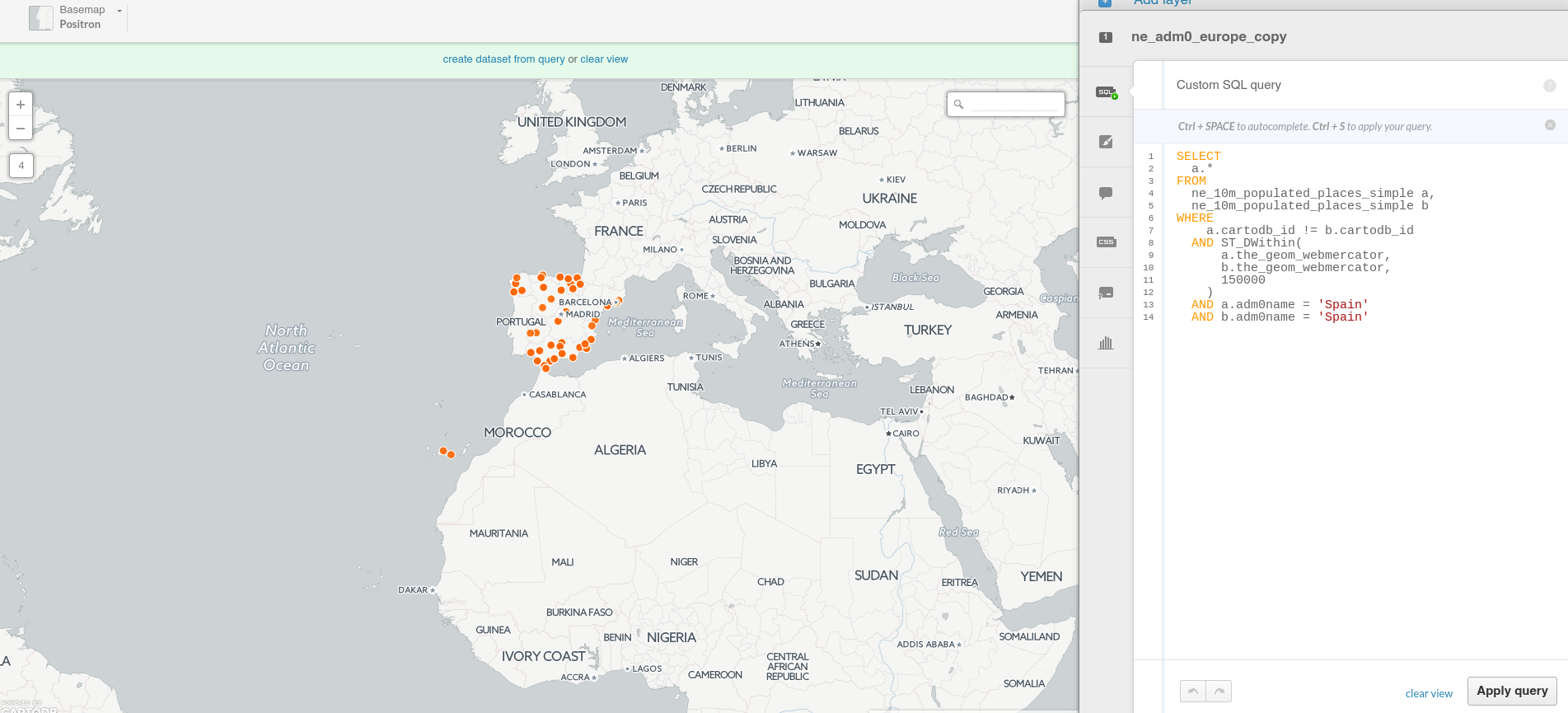
*About ST_DWithin.
- Create a straight line between two points:
SELECT
ST_MakeLine(a.the_geom_webmercator,b.the_geom_webmercator) as the_geom_webmercator
FROM (SELECT * FROM populated_places
WHERE name ILIKE 'madrid') as a,
(SELECT * FROM populated_places
WHERE name ILIKE 'barcelona'AND adm0name ILIKE 'spain') as b

*About ST_MakeLine.
- Create great circles between two points:
SELECT
ST_Transform(
ST_Segmentize(
ST_Makeline(
a.the_geom,
b.the_geom
)::geography,
100000
)::geometry,
3857
) as the_geom_webmercator
FROM
(SELECT * FROM populated_places
WHERE name ILIKE 'madrid') as a,
(SELECT * FROM populated_places
WHERE name ILIKE 'new york') as b
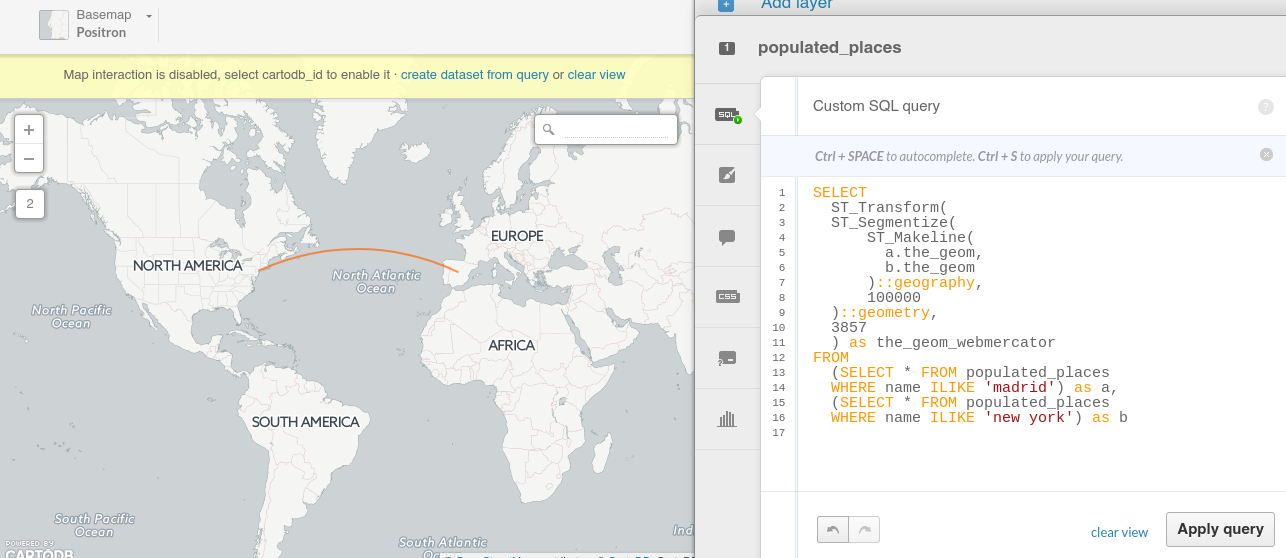
*About Great Circles.
5. Webmapping apps with CartoDB.js
5. 1. CartoDB.js
CartoDB.js is the JavaScript library that allows to create webmapping apps using CartoDB services quickly and efficiently. It’s built upon the following components:
- jQuery
- Underscore.js
- Backbone.js
- It can use either Google Maps API or Leaflet
Know more about CartoDB.js here and here.
5. 2. Create Visualizations and Layers
5. 2. 1. createVis
The most basic way to display your map from CartoDB.js involves a call to:
cartodb.createVis(div_id, viz_json_url)
Couched between the <script> ... </script> tags, createVis puts a map and CartoDB data layers into the DOM element you specify. In the snippet below we assume that <div id='map'></div> placed earlier in an HTML file.
window.onload = function() {
var vizjson = 'link from share panel';
cartodb.createVis('map', vizjson);
}
And that’s it! All you need is that snippet of code, a script block that sources CartoDB.js, and inclusion of the CartoDB.js CSS file. It’s really one of the easiest ways to create a custom map on your webpage. createVis also accepts options that you specifiy outside of the CartoDB Editor. They take the form of a JS object, and can be passed as a third optional argument.
var options = {
center: [40.4000, -3.6833], // Madrid
zoom: 7,
scrollwheel: true
};
cartodb.createVis('map', vizjson, options);
5. 2. 2. createLayer
If you want to exercise more control over the layers and base map, createLayer may be the best option for you. You specifiy the base map yourself and load the layer from one or multiple viz.json files. Unlike createVis, createLayer needs a map object, such as one created by Google Maps or Leaflet. This difference allows for more control of the basemap for the JavaScript/HTML you’re writing.
A basic Leaflet map without your data can be created as follows:
window.onload = function() {
// Choose center and zoom level
var options = {
center: [41.8369, -87.6847], // Chicago
zoom: 7
}
// Instantiate map on specified DOM element
var map_object = new L.Map(dom_id, options);
// Add a basemap to the map object just created
L.tileLayer('http://tile.stamen.com/toner/{z}/{x}/{y}.png', {
attribution: 'Stamen'
}).addTo(map_object);
}
The map we just created doesn’t have any CartoDB data layers yet. If you’re just adding a single layer, you can put your data on top of the basemap from above. If you want to add more, you just repeat the process. We’ll be doing much more with this later. This is the basic snippet to put your data on top of the map you just created. Drop this in below the L.tileLayer section.
var vizjson = 'link from share panel';
cartodb.createLayer(map_object, vizjson).addTo(map_object);
5. 3. UI Functions
5. 3. 1. Tooltips
A tooltip is an infowindow that appears when you hover your mouse over a map feature with vis.addOverlay(options). A tooltip appears where the mouse cursor is located on the map.
To add a tooltip to a map you need to do two steps:
First, define tooltip variable:
var tooltip = layer.leafletMap.viz.addOverlay({
type: 'tooltip',
layer: layer,
template: '<div class="cartodb-tooltip-content-wrapper"><p></p></div>',
width: 200,
position: 'bottom|right',
fields: [{ name: 'name' }]
});
Second, add tooltip to the map:
$('body').append(tooltip.render().el);
5. 3. 2. Infowindows
Infowindows provide additional interactivity for your published map, controlled by layer events. It enables interaction and overrides the layer interactivity. A pop-up information window appears when a viewer clicks on a map feature.
In order to add the CartoDB.js infowindow you need to add this line within your code:
cdb.vis.Vis.addInfowindow(map_object, layer, ['fields']);
However, you can create custom infowindows with different tools (Moustache.js, HML or underscore.js). Whatever choice you use, you would need to create a template first and then add the infowindow with the template. Here we will see how to do it using Moustache.js.
Mustache.js is a logic-less logic-template. That means that only tags you create templates that are replaced with a value or series of values, it works by expanding tags in a template using values provided in a hash or object.
Example: Custom infowindow template to display cartodb_id:
<script type="infowindow/html" id="infowindow_template">
<div class="cartodb-popup v2">
<a href="#close" class="cartodb-popup-close-button close">x</a>
<div class="cartodb-popup-content-wrapper">
<div class="cartodb-popup-content">
<h4>ID</h4>
<p>{{cartodb_id}}</p>
</div>
</div>
<div class="cartodb-popup-tip-container"></div>
</div>
</script>
Then you can apply the custom infowindow template to the map with:
cdb.vis.Vis.addInfowindow(
map, layer, [columnName],
{
infowindowTemplate: $('#infowindow_template').html()
});
5. 3. 3. Legends
In order to add legends with CartoDB.js you would need to define the elemenets and colors of the legend with HTML, then you could use the legend classes of CartoDB.js to create the legends.
There is two kind of legend classes:
First, cartodb-legend choropleth, applied in Choropleth maps:
<div class='cartodb-legend choropleth'>
<div class="legend-title">Population</div>
<ul>
<li class="min">
1256
</li>
<li class="max">
8300
</li>
<li class="graph count_441">
<div class="colors">
<div class="quartile" style="background-color:#FFFFB2"></div>
<div class="quartile" style="background-color:#FED976"></div>
<div class="quartile" style="background-color:#FEB24C"></div>
<div class="quartile" style="background-color:#FD8D3C"></div>
<div class="quartile" style="background-color:#FC4E2A"></div>
<div class="quartile" style="background-color:#E31A1C"></div>
<div class="quartile" style="background-color:#B10026"></div>
</div>
</li>
</ul>
</div>
Second, cartodb-legend category, applied in simple or category maps:
<div class='cartodb-legend category'>
<div class="legend-title" style="color:#284a59">Countries</div>
<ul>
<li><div class="bullet" style="background-color:#fbb4ae"></div>Spain</li>
<li><div class="bullet" style="background-color:#ccebc5"></div>Portugal</li>
<li><div class="bullet" style="background-color:#b3cde3"></div>France</li>
</ul>
</div>
5. 4. Examples
-
Add custom infowindow, infobox, tooltip & legend with with
createLayer(): example.